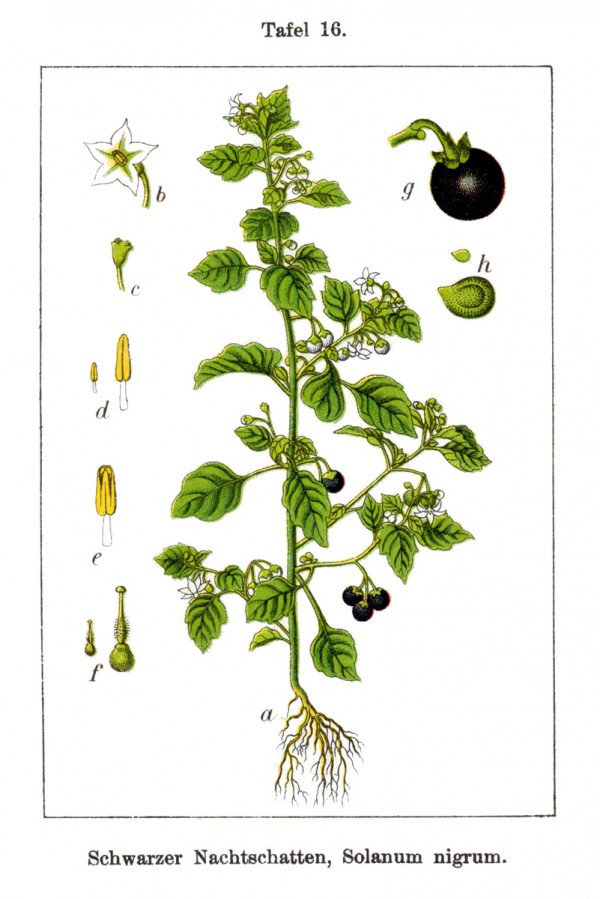Solanum nigrum L. - Solanaceae - black nightshade, wonderberry, Schwarzer Nachtschatten
Annual herb, 10-80cm high, native to the northern hemisphere; whole plant deep green; leaves simple, ovate; flowers funnel-shaped, 5-lobed, white; mature berries black or seldom greenish-yellow.
„Black nightshade contains toxic glycoalkaloids in the plant. The highest concentration is in the green immature berries. All kinds of animals can be poisoned after ingesting nightshade including cattle, sheep, poultry, and swine. Children have been poisoned and have died after ingesting unripe berries. The ripe berries cause reduced symptoms of mild abdominal pains, vomiting, and diarrhea.“
[„Notes on poisoning:black nightshade“, Canadian Poisonous Plants, Canadian Biodiversity Information Facility, Canadian Government.] http://www.cbif.gc.ca/eng/species-bank/canadian-poisonous-plants-information-system/all-plants-common-name/black-nightshade/?id=1370403267063
„Solanine, a glyco-alkaloid, is found throughout the plant, with the highest concentrations in the unripened berries. The concentration of solanine increases in the leaves as the plant matures (Cooper & Johnson, 1984). When ripe, the berries are the least toxic part of the plant and are sometimes eaten without ill effects (Watt & Breyer-Brandwijk, 1962)… The unhydrolyzed glyco-alkaloid (solanine) is poorly absorbed, while alkamine solanidine) is rapidly absorbed through the gastrointestinal wall. Alkamine is the active principle mainly responsible for the toxic manifestations… Animal studies comparing solanine with K-strophantidine revealed similar effects.“
[Solanum nigrum L., IPCS INCHEM, © World Health Organization, 1994] http://www.inchem.org/documents/pims/plant/solanum.htm
A cytotoxic assay showed the steroidal glycoside solamargine as the main antineoplastic agent in S. nigrum.
[Antineoplastic agents. III: Steroidal glycosides from Solanum nigrum., Hu, K., Kobayashi, H., Dong, A., Jing, Y., Iwasaki, S., Yao, X., Planta medica, 65(1), 1999, 35-38]
The saponin egalactotigonin, isolated from the whole plant of S.nigrum, was cytotoxic with IC50 values of 0.25-4.49 μM in four human tumor cell lines (HepG2, NCI-H460, MCF-7, SF-268).
[Steroidal saponins from Solanum nigrum., Zhou, X., He, X., Wang, G., Gao, H., Zhou, G., Ye, W., Yao, X., Journal of natural products, 69(8), 2006, 1158-1163]
„S. nigrum is widely used in many traditional systems of medicine worldwide for disparate ailments, but has not garnered attention for modern therapeutic use.“
[Solanum nigrum: current perspectives on therapeutic properties., Jain, R., Sharma, A., Gupta, S., Sarethy, I. P., Gabrani, R., Altern Med Rev, 16(1), 2011, 78-85] http://www.altmedrev.com/publications/16/1/78.pdf
„Solanum nigrum L. (SNL), a traditional Chinese medicinal herb endowed with diuretic, antipyretic and hepatoprotective effects, has been used as a major ingredient of folk prescriptions for anticancer treatment in China… SM [Solamargine, a major steroidal alkaloid glycoside purified from SNL] significantly inhibited the growth of SMMC-7721 and HepG2 cells and induced cell apoptosis. Cell cycle analysis revealed that SM caused cell cycle arrest at the G2/M phase. Moreover, SM could up-regulate the expression of caspase-3… SM exerted potential anticancer activity on SMMC-7721 cells in vitro through the activation of caspase-3 and the regulation of the cell cycle progression to induce apoptosis and inhibit hepatoma cells proliferation.“
[Induction of apoptosis in human hepatoma SMMC-7721 cells by solamargine from Solanum nigrum L., Ding, X., Zhu, F.S., Li, M., Gao, S.G., Journal of ethnopharmacology, 139(2), 2012, 599-604]

Sturm, J., Krause, E.H.L., Lutz, K.G., Flora von Deutschland in Abbildungen nach der Natur, Zweite Auflage, vol.10, t.16 (1903)
https://commons.wikimedia.org/wiki/Solanum_nigrum?uselang=de#/media/File:Solanum_nigrum_Sturm16.jpg
http://caliban.mpipz.mpg.de/sturm/flora10/high/IMG_10020.html
Solanum nigrum
© Rolf Marschner (2016),
www.botanische-spaziergaenge.at
